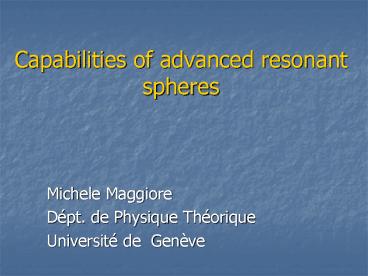Capabilities of advanced resonant spheres - PowerPoint PPT Presentation
Title:
Capabilities of advanced resonant spheres
Description:
Can resonant detectors be useful in the era of advanced ITFs ? Sensitivity ... Coccia, Fafone, Frossati, Lobo and Ortega (1998) Examples of applications of this ... – PowerPoint PPT presentation
Number of Views:25
Avg rating:3.0/5.0
Title: Capabilities of advanced resonant spheres
1
Capabilities of advanced resonant spheres
- Michele Maggiore
- Dépt. de Physique Théorique
- Université de Genève
2
Can resonant detectors be useful in the era of
advanced ITFs ?
- Sensitivity
- Complementarity of the informations
- Practical aspects (duty cycle, costs, )
3
Sensitivity
- a resonant sphere, with R 1m, M33 ton
- at the SQL, can reach (see talk of E.
Coccia) - Sh (f) 3 10-23 Hz-1/2
- over a bandwidth ?f 200 Hz
- centered around f 1 kHz
- in this bandwidth , this is comparable to 2nd
generation ITFs
4
(No Transcript)
5
- based on straightforward extensions of existing
technologies - read-out at 20 h already achieved
- cooling of large resonant-masses to
- T0.1 K already demonstrated
- (? 2nd generation )
- further improvement in principle possible
- read-out dual, QND techniques
- larger masses e.g. hollow sphere, R2m, M200
ton, at the SQL - Sh (f) 5 10-24 Hz-1/2 at f 400 Hz
- (? 3nd generation )
6
Complementarity
- resonant bars, ITFs only one output
- ? hF(?,f ) h F(?,f )
- sphere 5 outputs, the 5 degenerate quadrupolar
modes - ? the two polarizations h and h
- ? the propagation direction n (mod n ? - n )
- ? one veto
7
Angular sensitivity
- define ?O p (??)2 sin2? (?f)2
- ? for a sphere ?O 2p /SNR
(Zhou-Michelson 1995) - better than a 3-ITF correlation!
- a unique telescope 4p coverage good
angular resolution - in a 5-mode system, it is enough to have
- an average SNR2 per mode to get a total
SNR10 - the duty cycle of a single sphere could be much
- larger than the common time of a 3 ITF
correlation
8
The veto
- hij ni nj Sm hm Y2m m-2,,2
- the sphere measures the 5 quantities hm
- ? reconstruct the matrix hij
- ? check that is has a zero eigenvalue
- (within a precision O(1/SNR) )
- we are checking the transverse nature of GWs !
- Powerful way to discriminates GWs from noise
- (easily implemented as an on-line
trigger )
9
Multi-frequency capability
- Resonant bars
- sn 1/n2, (n odd)
- ? the first harmonic (n3) has
- f3 3 f1 , s3 (1/9) s1
- for a sphere ,
- f n2,l2 2 f n1,l2
- sn2,l2 0.4 sn1,l2
- for hollow spheres, one can
- even have sn2,l2 sn1,l2
- (Monitored with two TIGAs)
Coccia, Fafone, Frossati, Lobo and Ortega (1998)
10
Examples of applications of this multi-mode,
2-window system
- Bursts with power both at f1 and f2
- at f1
- pass one veto (transversality)
- determine the direction
- measure h and h at f1
- at f2
- pass one more veto (transversality)
- a second independent determination of the
direction ! - (optical counterpart ?)
- one more veto from the n1 monopole mode
- measure h and h at f2 (spectral
informations) - Unprecedented level of background rejection !
11
- Coalescing binaries
- h (2/r) Mc5/3 (p f )2/3 (1cos2 ? )
cos F - h (4/r) Mc5/3 (p f )2/3 cos ? sin
F - df/dt (95/5) p8/3 Mc5/3 f11/3
- If the sphere is very massive so that the second
window is still in the coalescing phase - from the time needed to sweep between the two
windows ? Mc
(Coccia and Fafone, 96) - Then we can repeat the standard argument
- that coalescing binaries are standard candles
(Schutz, 86) - h/h gives cos ?
- h or h now give r (luminosity distance)
- Furthermore
- the sphere also gives the direction
12
- Stochastic backgrounds
- sphere-sphere correlation ?mm dmm
- 20 vanishing off-diagonal correlators
- ? signal chopping
- 5 identical diagonal correlators
- effective integration time T? 5 T
- sphere-ITF correlation
- 5 correlators ITF with the mode (m-2,,2)
- the correlators with m0, 1 vanish (?
chopping) - the correlators with m2 are equal
13
Can resonant detectors be useful in the era of
advanced ITFs ?
- Sensitivity
- competitive, in a smaller bandwidth
- Complementarity of the informations
- source direction , h and h separately
- 4 p coverage
- high background rejection
- Practical aspects (duty cycle, costs, )
- much higher than the common time of 3 ITF
- costs of order 2 of an advanced ITF































